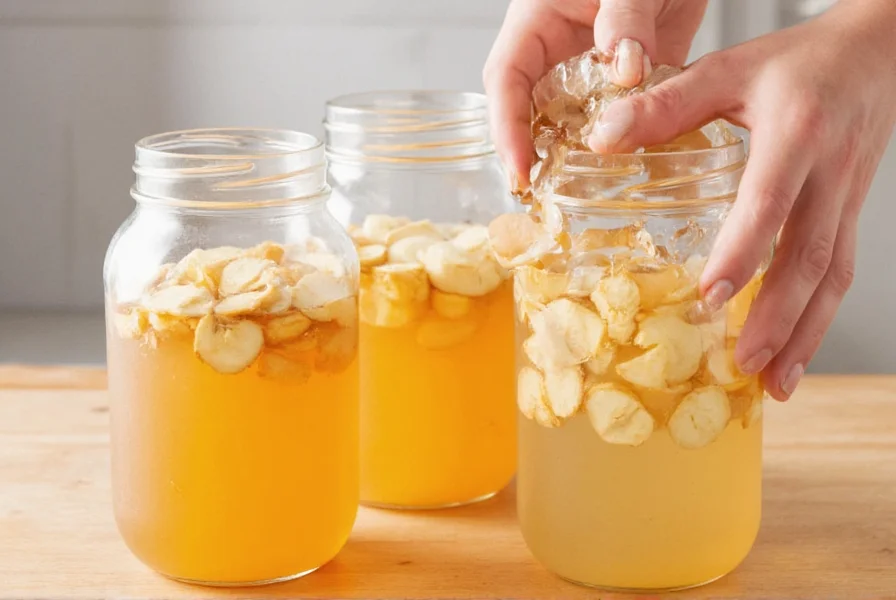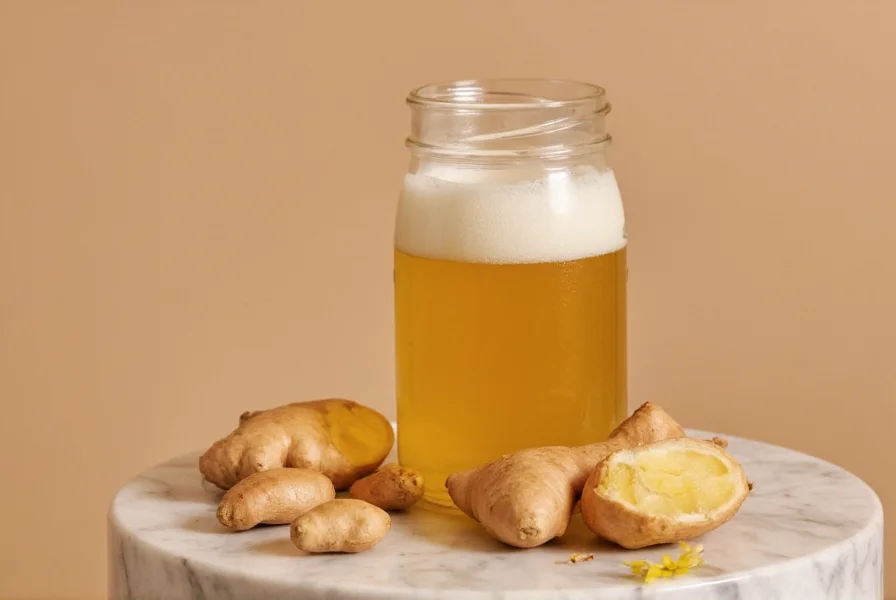Ginger root kombucha has gained significant popularity among health-conscious consumers seeking natural fermented beverages with added functional benefits. Unlike standard kombucha, this variation incorporates fresh ginger root during fermentation, creating a distinctive spicy flavor profile while potentially enhancing the beverage's health properties. The fermentation process transforms sweetened tea into a probiotic-rich drink through the action of a symbiotic culture of bacteria and yeast (SCOBY), with ginger adding both flavor complexity and potential therapeutic compounds.
What Makes Ginger Root Kombucha Unique
Ginger root kombucha differs from traditional kombucha primarily through the addition of fresh ginger during the secondary fermentation stage. While basic kombucha consists of tea, sugar, water, and a SCOBY, ginger root kombucha introduces Zingiber officinale (ginger root) as a key ingredient. This addition creates a beverage with a distinctive spicy kick and potentially enhanced health properties.
The ginger root contributes gingerols and shogaols—bioactive compounds with documented anti-inflammatory and antioxidant effects. When combined with the organic acids, B vitamins, and probiotics produced during kombucha fermentation, the resulting beverage offers a complex phytochemical profile that may provide synergistic health benefits.

Scientifically Supported Health Benefits
Research indicates several potential health benefits associated with ginger root kombucha, though it's important to note that most studies examine ginger and kombucha separately rather than in combination:
| Component | Key Compounds | Potential Benefits |
|---|---|---|
| Ginger Root | Gingerols, Shogaols | Digestive support, anti-inflammatory effects, nausea reduction |
| Kombucha Base | Acetic acid, Gluconic acid, Glucuronic acid | Gut microbiome support, potential detoxification properties |
| Combined Effect | Synergistic compounds | Enhanced digestive benefits, improved nutrient absorption |
A 2020 review published in Food Science & Nutrition highlighted ginger's effectiveness in reducing nausea and supporting digestive health, while research in Frontiers in Microbiology has documented kombucha's probiotic potential. When combined, these elements may create a beverage with enhanced functional properties, particularly for digestive wellness.
The Fermentation Process: How Ginger Root Kombucha Is Made
The production of ginger root kombucha follows the standard kombucha fermentation process with specific modifications to incorporate ginger:
- Primary fermentation: Brew sweetened tea (typically black or green tea) and add a SCOBY with starter liquid
- Ginger addition: During secondary fermentation (after removing the SCOBY), fresh grated or sliced ginger root is added to the kombucha
- Carbonation period: The mixture ferments for 2-7 days, allowing ginger flavors to infuse and additional carbonation to develop
- Bottling: The ginger root kombucha is strained and bottled, often with additional flavorings
- Mature fermentation: Bottles are stored at room temperature for 1-3 days to develop carbonation before refrigeration
The timing of ginger addition significantly affects the final product. Adding ginger during primary fermentation creates a more subtle flavor with potentially greater compound integration, while secondary fermentation yields a more pronounced ginger taste. Most home brewers prefer secondary addition for better flavor control and to prevent potential interference with the SCOBY's activity.
Creating Ginger Root Kombucha at Home: A Practical Guide
Home preparation of ginger root kombucha offers control over ingredients and fermentation while ensuring freshness. Follow these evidence-based guidelines for safe and effective production:
Essential Ingredients and Equipment
- Organic black or green tea (4-6 tea bags or 2 tablespoons loose leaf)
- Organic cane sugar (1 cup per gallon of water)
- Filtered water (free from chlorine and other chemicals)
- Fresh organic ginger root (2-3 inches, peeled and grated)
- Active SCOBY with 1-2 cups starter liquid
- Glass fermentation vessel with breathable cover
- Plastic or wooden utensils (avoid metal)
- Airtight glass bottles for secondary fermentation
Safety Considerations for Home Fermentation
Proper food safety practices are essential when making ginger root kombucha at home:
- Maintain strict cleanliness of all equipment to prevent contamination
- Use only non-reactive containers (glass is ideal)
- Monitor fermentation temperature (75-85°F or 24-29°C is optimal)
- Discard batches with mold or unusual odors
- Release pressure from bottles daily during carbonation phase
- Store finished kombucha refrigerated to slow fermentation
Comparing Ginger Root Kombucha to Other Varieties
Ginger root kombucha offers distinct advantages and characteristics compared to other kombucha varieties:
- Flavor profile: More complex and spicy than fruit-flavored varieties, with warming notes that appeal to those who find traditional kombucha too vinegary
- Digestive benefits: The ginger component provides additional digestive support beyond standard kombucha's probiotic effects
- Functional properties: Ginger's anti-nausea and anti-inflammatory properties complement kombucha's potential health benefits
- Versatility: Works well as a base for additional flavorings or as a mixer in non-alcoholic beverages
Unlike fruit-based kombuchas that may contain higher sugar content from added fruit juices, ginger root kombucha typically maintains a lower sugar profile while still offering robust flavor. This makes it particularly appealing to those monitoring sugar intake while seeking functional beverage options.
Potential Considerations and Limitations
While ginger root kombucha offers potential benefits, several important considerations should be noted:
- Acidity levels: The combined acidity of kombucha and ginger may cause discomfort for individuals with acid sensitivity
- Alcohol content: All kombucha contains trace alcohol (typically 0.5% or less); extended fermentation increases this slightly
- Ginger sensitivity: Some individuals may experience heartburn or digestive upset from ginger
- Medication interactions: Ginger may interact with blood thinners and diabetes medications
- Pregnancy considerations: Consult healthcare providers before regular consumption during pregnancy
As with any functional food, moderation is key. Most experts recommend starting with 4 ounces daily and gradually increasing to assess individual tolerance. Those with compromised immune systems or specific health conditions should consult healthcare providers before incorporating ginger root kombucha into their regular diet.
Conclusion: A Balanced Perspective on Ginger Root Kombucha
Ginger root kombucha represents an interesting fusion of traditional fermentation practices with functional botanical ingredients. When properly prepared and consumed as part of a balanced diet, it may offer digestive support, anti-inflammatory benefits, and a flavorful alternative to sugary beverages. However, it's essential to maintain realistic expectations about its health effects and recognize that it complements—but doesn't replace—other healthy lifestyle practices.
The growing body of research on both ginger and kombucha suggests potential benefits, but more studies specifically examining their combination would provide valuable insights. For now, ginger root kombucha stands as a tasty, potentially beneficial fermented beverage that home brewers and commercial producers continue to refine and perfect.
Frequently Asked Questions
What are the primary health benefits of ginger root kombucha?
Ginger root kombucha combines the probiotic benefits of kombucha with ginger's digestive and anti-inflammatory properties. Research suggests it may support gut health through beneficial bacteria, aid digestion through ginger's compounds like gingerols, and provide antioxidant effects. However, individual results vary and it should be considered a complementary beverage rather than a treatment for specific conditions.
How much ginger should I use when making ginger root kombucha at home?
For a one-gallon batch during secondary fermentation, 2-3 inches of fresh peeled ginger (grated or sliced) typically provides optimal flavor without overwhelming the kombucha. This equals approximately 1-2 tablespoons of grated ginger. Adjust based on personal preference, but avoid excessive amounts that might interfere with carbonation or create overly spicy results.
How long does homemade ginger root kombucha last in the refrigerator?
Properly stored homemade ginger root kombucha typically maintains best quality for 1-2 months in the refrigerator. The cold temperature slows but doesn't stop fermentation, so flavor will continue to develop (becoming more vinegary over time). Always check for mold, off odors, or excessive pressure before consuming, and discard if any appear.
Can ginger root kombucha help with nausea and digestive issues?
Both ginger and kombucha have documented digestive benefits. Ginger contains compounds that may help reduce nausea, while kombucha's probiotics support gut health. Some people find ginger root kombucha particularly helpful for occasional digestive discomfort, but scientific evidence specifically for the combined product is limited. Those with chronic digestive issues should consult healthcare providers rather than relying solely on kombucha.
Is store-bought ginger root kombucha as beneficial as homemade?
Commercial ginger root kombucha often undergoes pasteurization or filtration that reduces live probiotic content. Look for products labeled "raw," "unpasteurized," and "contains live cultures" for maximum potential benefits. Homemade versions typically contain higher levels of live cultures but require proper food safety practices. Both can be part of a healthy diet, but homemade generally offers more control over ingredients and fermentation.











 浙公网安备
33010002000092号
浙公网安备
33010002000092号 浙B2-20120091-4
浙B2-20120091-4